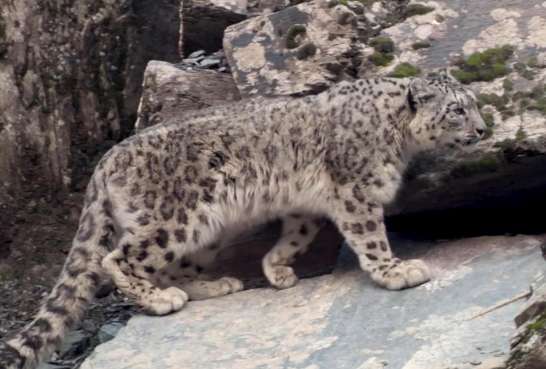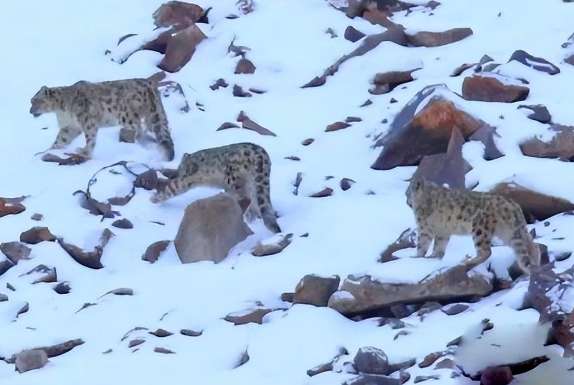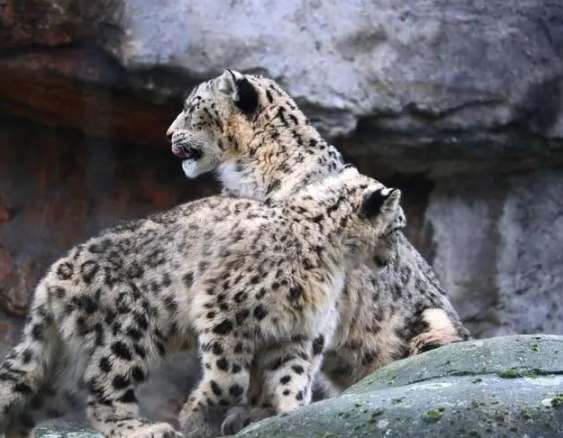Snow leopards were once an extremely endangered big cat and were once on the verge of extinction. Fortunately, people later realized their importance and gradually increased their protection efforts. As the ecological environment gradually improved and animal protection awareness gradually became popular, the number of snow leopards also began to increase.
After years of hard work, finally in September 2017, the snow leopard’s endangered level was successfully reduced from the original “endangered” to “vulnerable”. This is absolutely exciting in the field of animal protection. Good news for people’s hearts. my country's protection of snow leopards is one of the best success stories in the field of wildlife protection in the world.

Snow leopards They thrive in numbers, as evidenced by the increasingly frequent sightings. For example, recently, the staff of the Taxkorgan Wildlife Nature Reserve in Xinjiang encountered snow leopards during their daily patrol. It was a rare sight of four snow leopards in the same frame.
The Taxkorgan Nature Reserve covers an area of about 16,000 square kilometers. It is located on the Pamir Plateau, which is formed by the intersection of the Kunlun Mountains and the Himalayas. There are many, but there are many rare and endangered species, such as ibex, snow leopard, blue sheep, argali, etc., most of which are plateau species.
In these years, it is not uncommon to encounter snow leopards, but four snow leopards are found in the field of vision at the same time. This kind of scene is rare not only in life, but also in the work of mountain patrol members. .

The reason is very Simple, because among modern cats, only lions live in groups, and most cats, including snow leopards, live alone. As the top predator in the plateau snow mountain ecosystem, snow leopards are naturally highly solitary.
There are only two exceptions. One is that during the estrus period, the paired males and females will live together for a short period of time until they mate.After the female becomes pregnant, the male will leave. The second is the situation of mother animals raising cubs. Judging from their size, the four types of snow leopards discovered by mountain patrol staff are most likely to be in this second situation.
As people study cats more and more deeply, they find that the boundary between living in groups and living alone is not as clear as originally thought. In fact, it is very blurred. Lions living in groups also have time to live alone, and solitary animals will occasionally appear in "transient clusters". This has been found in a large number of cats such as tigers, cheetahs, and pumas.
Snow leopards are solitary animals in the traditional sense. Under normal circumstances, they will live alone after they grow up and leave their mothers. However, some young individuals who have left home not long ago will occasionally encounter them in the wild. , it is also possible to act together, but of course this phenomenon is very rare.
The estrus period of wild snow leopards usually occurs from January to March in late winter. The estrus period of female animals lasts for about 5-8 days. During this stage, they will live together with male animals and will separate after mating. . If pregnancy does not occur, the female will go into heat again in about three weeks and repeat the previous steps.

Snow leopards The gestation period is generally about three months, so mid-April to early June every year is the season for snow leopards to give birth. They usually have 2-3 cubs in one litter, most are 2, and a few are one or 4 or 5 cubs. Newly born snow leopard cubs are very small and completely dependent on the mother leopard. They cannot go out with the mother until they are 2 months old.
For little snow leopards, the most important thing about living with their mother is to learn various hunting techniques and survival experiences.
Two months after birth, when the snow leopard cubs are able to go out and move around, the mother leopard will gradually teach some hunting and fighting skills to the cubs. At the same time, in order to consolidate these skills, little snow leopard brothers or sisters will play and fight with each other to practice their hunting ability during play.
After another month or two, the little snow leopard can follow the mother leopard to participate in hunting activities. Especially during the period of 12-18 months, the little snow leopard has become proficient in various hunting abilities and its size has improved. It has also risen sharply, and it can definitely be regarded as the female leopard's right-hand man. At this stage, the mother leopard will patrol the habitat with her cubs, searching for traces of prey throughout the mountains and plains. It is not until 18-22 months later that the little snow leopard will leave its mother and live independently.
Snow leopards are a plateau species, mainly inhabiting snow-capped mountains at an altitude of 3,000-5,000 meters.In summer, activities are at higher altitudes, while in winter they move to lower altitudes.
They like to stay in dry and cool environments, especially in mountainous and rocky areas, which are the home ground of snow leopards and their main hunting ground. Everyone knows that areas with higher altitudes are often cold and hypoxic, so how can snow leopards adapt?
Scientists have found that plateau species, including snow leopards, possess a gene called "EPAS1". Under the influence of this gene, plateau species are very sensitive to changes in oxygen. Possessing superb skills in distributing blood and regulating breathing.
Snow leopards' gray-white hair with dark spots is a good camouflage in the bare rock areas of snowy mountains. Like tigers, they hunt in ambush.
When discovering blue sheep, argali and other prey, snow leopards will first lurk. When the prey enters the ambush circle, they will quickly jump out and pounce on the prey. The entire hunting process is very efficient. As a large predator in the plateau snow mountain ecosystem, snow leopards mainly prey on medium and large ungulates such as blue sheep, argali, and ibex.
Of course, these ungulates are not easy to deal with. They have super strong mobility and can walk quickly on rocky terrain. In order to better move on bare rocky areas, snow leopards have evolved a thick and long tail during the long process of species evolution to maintain balance when running.
Snow leopards are distributed in 12 countries in Central Asia, and 60% of their habitats are located in my country. Therefore, my country is also the country with the largest number of snow leopards, accounting for more than half of the global number.
There are about 7,500 wild snow leopards in the world, of which about 4,500 live in our country. Therefore, it is unceremoniously said that "the protection of snow leopards in the world depends on China", and our country has delivered in this regard to the satisfaction of the world. answer sheet. In the future, as the ecology further improves, the number of snow leopards will continue to increase, and I believe the probability of people encountering them will also increase.